Few sports have a history as enduring and riveting as archery that spreads throughout generations making it an area for fans to experience, enhance, and flourish.
The tangible changes in archery equipment and coexistence of the traditional gear are proof that people appreciate innovations but not at the expense of the older versions of bows and arrows.
So, it’s no surprise that archery bows are available in variable shapes and styles to help archers achieve their specific shooting and bowhunting goals.
Wondering which bow types help accomplish what? Well, here it goes.
In this article, you’ll be reading about the different archery bows; more specifically, the types of compound bows and traditional bows.
Archery Bow Types
Archery bows were no more than a simple weapon. But, it turns out to be a great one if associated with quality archery arrows.
What once was a battle/combat item has now been a very popular sports tool. Time has set the course of what today’s bows have been.
1. Recurve Bows
The basic difference between recurve bows and other bows is in the tip of the limbs.
In most bows, limb tips curve towards the archer. But in recurve bows, tips of the limbs curve back the other way.
Design/Construction
Recurve bows consist of three parts
- Riser (The bow’s center section that has the limbs attached to it)
- Limbs (The extremities of the bow where the string is attached and provide the shooting force)
- Grip (The part of the riser that the archer holds)
These bows come in two popular styles, such as modern and traditional recurves. Let’s take a look at the following details.
Modern Recurve
Recurve bows of modern times are manufactured from fiberglass and carbon foam. They are characterized by the curved tips at either end of the arms.
This design facilitates increases in the speed of the bow and the smoothness of the release.
Design/Construction
The design of a modern recurve bow is simple. Upon detaching or removing the string, the bow was dismantled into three parts.
The two equal-length parts are called limbs.
There is a central part in the middle of the bow which acts as a bridge between two limbs.
This is called a riser where you grab the bow with one hand.
While different types of materials, for example, wood, and fiberglass carbon are used to make limbs but risers are mainly made of either wood or carbon.
Advantages
- Arrows can be released smoothly. That is why modern recurve bows have widespread use in target archery and the Olympics.
- They can be used in field archery & 3D archery.
Disadvantages
- Does not have a higher arrow velocity
Traditional Recurve
Traditional recurve bows are made either from single pieces of wood or wood composition.
Mongolian and Turkish soldiers used this type of bow. These are one of the traditional types of bow.

Design/Construction
These historical bows were made from bone and horns wrapped in leather.
They go through further modification by people of different ethnicity living in central Asia.
Alteration of the design of the bow was required so that warriors can use it while riding a horse.
Traditional Recurve bows are still manufactured to give archers some medieval experience of hunting.
Advantages
- These bows are ideal for mounted archery. Archers can ride horses at a greater speed while shooting at targets along their path.
Disadvantages
- Using these bows requires a lot of skill.
Takedown Bows
A takedown bow comes with simple design-two limbs are attached to the bow riser. The great utility of the bow is its easy portability and storage.
Simply disassemble different parts of the bow, put them in a small case and the bow is ready to carry or store.
Another great advantage of the bow is that the bow is highly customizable.
Archers can change the limbs o the bow according to their hunting or shooting requirements.

Design/Construction
The limbs of takedown bows are made of fiberglass. And the riser is made of alloy, carbon, aluminum, or wood.
Advantage
- They are quite portable
- They are inexpensive and easy to use.
- While practicing, you can quickly and cheaply increase draw weight by changing limbs. Thus, it may help to develop your muscles and get stronger.
Disadvantages
- Maintaining accuracy consistently may become hard in this type.
2. Crossbows
Modern crossbows have many similarities with firearms. They have a short bow attached horizontally to the muzzle. Crossbows can be held as a gun or rifles.
China is believed to be the birthplace of crossbows. Crossbows are weapons of the medieval era.

Design/Construction
The crossbow features a mechanism that allows archers to draw the string fully and latched it into its place as long as the trigger is not pressed.
The specific arrow designed for crossbows is called “Bolts and pressing the trigger propels the arrow like a bolt.
Crossbows come with one special type. They are called the pistol crossbow since they are held and fire much like a pistol
Advantages
Some specially designed crossbows are great for target archery.
But make sure you know the rules of the competition because regulations regarding crossbows can be quite strict.
Disadvantages
- Crossbows do not have long firing ranges.
- They are heavier than compound and recurve bows.
- Crossbows are difficult to carry
3. Flat Bows
Unlike other bows, the limbs of flat bows are not curved and are relatively wide. Tribes of different native Americans used the bow.

Construction/Design
Flat bows are made with one piece of wood. Because of their wide limbs, flat Bows are narrow.
The Cross section of the bow where two limbs are attached to each other is rectangular in shape.
Advantages
- The flat bow withstands rigorous stretching since it evenly disperses stress between two limbs.
Disadvantages
- Making the rectangular cross-section isn’t very easy.
4. Longbows
A longbow is the simplest style of bow among others. The bow is just a piece wood of attached to a string.
The longbow was the weapon of English soldiers from the 14th century until the advent of firearms.
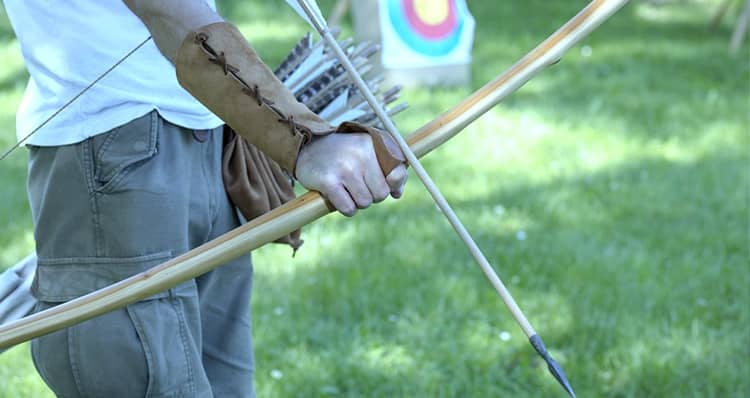
Construction/Design
A longbow features rounded limbs and is normally as big as an archer standing over 5 feet (1.5 m) to allow a full draw. ?
When the string is pulled, the longbow curves gently toward the archer forming the shape of the letter “D.” These bows are made of a single strip of wood.
Modern longbows do not differ markedly from their historical counterparts.
Advantages
- Crafting the bow is easier. Skilled bowyers can make a wooden longbow in just a couple of hours.
Disadvantages
- Aiming a target with a long bow is difficult
- They lack in velocity compared to compound or recurve bows
- The longbow requires more practice and patience to become a skilled archer.
- You require hours of practice to become an expert longbow archer.
5. Reflex Bows
The reflex bow features curved arms and a curve face away from the archer.
When you remove the string from the bow, the whole body of the bow bend forward into a C-like shape.
Mongol warriors used the bows during their Asian and European expeditions.
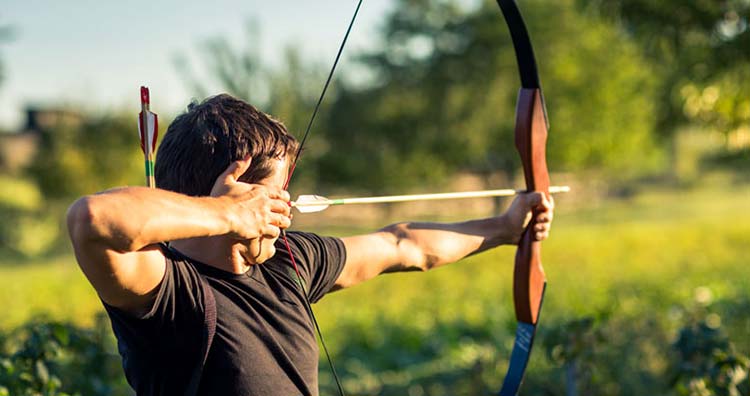
Construction/Design
The materials from which these bows are made withstand a whole lot of pressure.
Because while shooting, the archers need to flex back the bow from the bend forward position. And, this enables the bow to propel the arrow with a strong force.
Advantages
- Archers can shoot more forcefully
Disadvantages
- The bow is difficult to draw fully.
6. Yumi Bows
Yumi was used primarily by the Japanese. These were the favorite bows of samurai warriors. At the present time, three types of Yumi Bows are available.
These are yumi bows manufactured synthetically, Yumi bows made from jacquard bamboo, and a Yum bow made of simple bamboo.
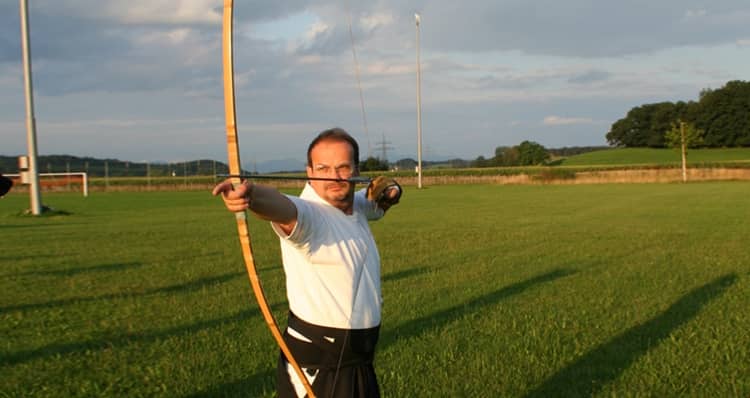
Construction/Design
The Yumi bow is usually designed to be taller than the archer.
The material of this type is a combination of bamboo and wood. Since bamboo isn’t very resistant to damage.
So, it is replaced by modern materials like fiberglass or carbon fiber. It is an asymmetrical bow. Asymmetrical means the lower part is shorter than the upper part.
Advantages
- Shooting from horseback and from a kneeling position is easy thanks to its asymmetrical shape.
Disadvantages
- Yumi bows need a lot of care and can lose their shape if not maintained well.
7. Compound Bows
Compound bows include one special levering system when it comes to drawing the bow completely.
That special levering system incorporates a pulley and cable mechanism so that archers can pull the bow with ease.
Since less effort is required to keep the bow fully drawn, the archer achieves better aim and increased accuracy.
These bows can be classified in terms of the number of their cams and designs. I’ll be discussing four compound bow types (according to the cams).
Single Cams
Single-cam compound bows are ideal for novice archers. Because they are easier to pull and shoot. But arrows shot from them have lower velocity.
Construction/Design
Single cam compound bows feature a single “power cam” at the bottom of the bow, while the cam at the top of the bow simply holds the string in place and does not increase the draw weight of the bow.
The top wheel of the single cam is also called the idler wheel.
Advantages
- Single cam compound bows require less maintenance.
- They have quiet operation.
Disadvantages:
- They have low arrow velocity.
Twin Cams
Twin cam compound bows provide the highest degree of accuracy and speed. But they are noisier and that could hamper your bow hunting.

Design/Construction
Twin cam compound bows feature two power cams attached at the top and bottom of the bow’s arm.
The sizes of camps can be either round or elliptical.
Advantages
- They offer the highest velocity of the arrow as well as accuracy
Disadvantages
- These bows are noisy requiring complicated maintenance
Binary Cams
Binary compound bows offer more accuracy than twin-cam compound bows.
Another advantage of binary type over twin compound bows is they require less maintenance.
Construction/ Design
Like twin cams, Binary cam compound bows utilize two power cams. But in this case, the cams are linked together instead of attaching to the bow’s arm.
In this type, correcting imbalances between two cams is easier than their twin counterpart.
Advantages
- Offers very high velocity.
Disadvantage
- Highly complex design.
- Not suitable for beginners.
Hybrid Cams
Hybrid cam compound bows are more precise to hit targets than twin or binary types.
Construction/ Design
Hybrid cam compound bows have evolved to correct design flaws of both twin and hybrid types. Their top cam does not harness any power to the bow.
But it acts like a control cam that stabilizes the power cam at the bottom of the bow.
Because of this power stabilization, they offer more accuracy.
Advantages
- They are highly precise for target shooting.
- These bows require a little maintenance.
Disadvantages
- These bows deliver low arrow velocity.
- You won’t love it much for hunting.
Among the above types, crossbows and compound bows are the most popular choices while others also enjoy some prominence.
With all the differences, merits, and downsides in mind, you can find what suits your needs most.
But I tell you what; be careful about the laws on crossbows and other bow types because you don’t want to jeopardize your career/pursuit as a bowhunter or archer.
Write to me anytime you need to know anything more or you just want to share your thoughts with me and my community!

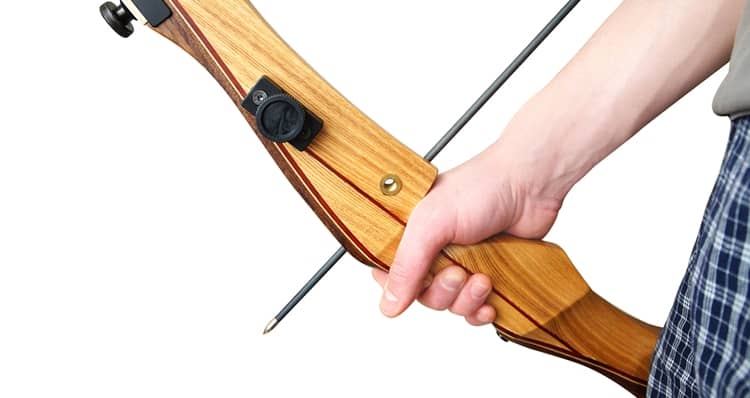






Leave a Comment